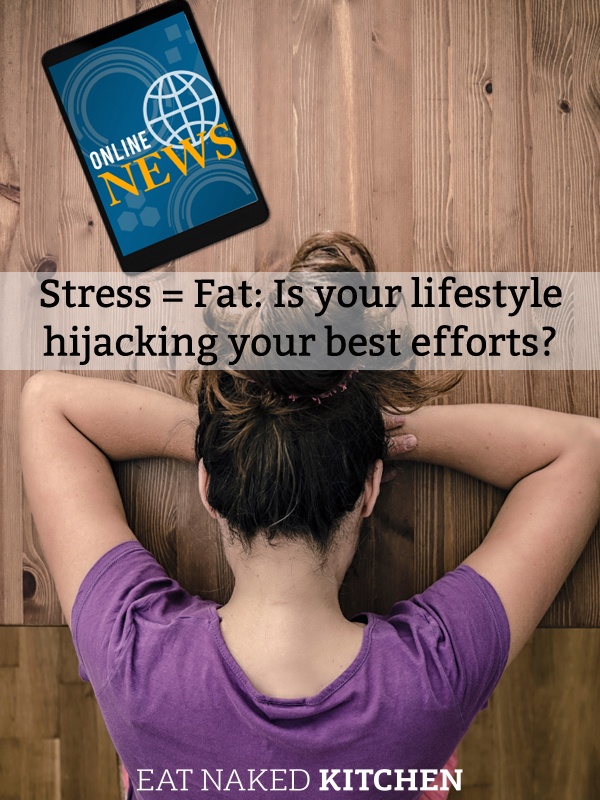A few weeks ago I shared my hypothesis that the unprecedented rates of H-Pylori I’m seeing in clinical practice are due, in part, to these higher levels of stress. (If you aren’t sure what H-Pylori, or Helicobacter Pylori, is and what I’m talking about, watch this video). Well, I’m sure it will come as no surprise that it’s not just our stomach acidity that’s affected by stress. Among all the health issues stress exacerbates, the inability to lose weight is right up there top of the list.
My colleague Lisa Thompson wrote about this phenomenon and how this critical lifestyle factor will hijack our best efforts, and needs to be considered in any weight loss strategy. I’ll let her take it from here…
Delving in a little deeper from where Margaret left off in a previous blog post, I wanted to offer you some practical solutions that are fairly easy to implement if cortisol is hijacking your best efforts at staying in a parasympathetic state.
Are you frustrated the numbers on the scale won’t budge? Do you have a seemingly endless number of deadlines to meet? Is there the day to day challenge of trying to balance work, life, family, and friends? Do we even need to mention a global pandemic, mass economic uncertainty, social unrest, a polarized political system with an election around the corner?
Let’s do a review of Stress Physiology 101:
STRESS = CORTISOL
The Standard American Diet (SAD) with its never-ending sugar spikes and crashes also trigger the release of cortisol…. And when there’s too much cortisol in the blood, where does it go? You got it: Directly to FAT storage.
The body’s main goal is to always be in homeostasis, equilibrium, and balance. The body’s natural state is health, not dis-ease. It strives to be in a parasympathetic state (aka: rest and digest = RELAXED as opposed to a sympathetic state = SURVIVAL).
Simply put, when we are stressed we absolutely work against ourselves – all those things we so desperately want to achieve, get hijacked by a hormone.
The antidote you ask? Finding ways to stay in that parasympathetic – relaxed – state.
Take Kathleen, a client of mine who is a perfect example of this phenomenon, and who I think on some level we can all relate to. I’m going to share with you some of the work we’ve done together to help her decrease her cortisol levels and increase her health and vitality.
Kathleen is a super happy, people-pleasing, and energetic spirit. She has an extremely demanding job working as an executive assistant at a large hospital, and struggles with long hours at a stressful job and staying on top several projects at a time. Kathleen loves her work and gets great satisfaction knowing she is very good at her job. However, she suffers from physical, mental, and emotional issues that stem from adrenal dysregulation.
In the last few years, she has suffered from acid reflux, anxiety, and an inability to get good sleep – all of which have been treated with medication. When the weekend rolls around she is often unable to get out of bed until noon, and if she catches a cold, or a touch of the flu – she is OUT for at least a week if not two!
Here are some of the ways I guided Kathleen towards getting into her parasympathetic nervous state.
- She stopped beating herself up on the treadmill and going to boot camp or spin classes, and switched to Pilates and restorative yoga classes, and spending more time with animals (scientific evidence supports the calming effects animals have on humans).
- She started making better dietary choices by increasing her intake of good dietary fats (fats are required to make hormones) and adding sea salt to the water she drinks (each endocrine gland has a mineral that is especially nurturing to it, for the adrenals, it’s sea salt).
- When she took a new job last spring she made it clear to her new boss that her health is a priority, and has begun to slow down – she takes breaks at work to walk around the block and get some fresh air, and takes her lunch away from her desk, mindfully eating and breathing to aid in digestion.
- Thanks to the changes she made through our work together, Kathleen’s acid reflux has completely disappeared, and the medications she uses to ease anxiety and assist with sleep, have all been lowered, and her hope and intention is to be off all medication soon.
Isn’t she inspiring? What from Kathleen’s story can you implement in your own life?
Here are some other ways to help ease you into parasympathetic mode:
- Meditation. This doesn’t have to be time-consuming or complicated. Just sitting with your eyes closed for 10 minutes a day, with the tip of your tongue fixed to the roof of your mouth and focusing on your breath, a spot on the wall, or the flame of a candle will do the trick.
- Breathwork. A very simple breathing technique we often use is to breathe in through your nose for a count of 4, hold for a count of 7, and breathe out through your mouth for a count of 8. Repeat four times.
- Consciously visualizing your self in a serene and peaceful setting. Get specific, a meadow/forest/lake/mountain top – define it and describe it in your mind: flowers, trees, snow, sun, cool or warm air, smell, etc..
- Just closing your eyes and seeing/guiding your breath as it moves through your body to spaces and places where energy might feel “stuck”: inhaling through the nose, and exhaling through the mouth (with energy through a small opening of the lips) to blow out/ removing any toxins, stagnant energy or debris that isn’t serving you.
- Another great place to live in your mind is in a state of gratitude. When we focus on gratitude, be it someone or something we are truly grateful for, or holding in our thoughts someone who we aspire to be more like, one who embodies the true essence of living in a state of grace: compassion, loving-kindness, humor, respect of self and others, sense of peace and well- being. When we are living in a state of gratitude, stress cannot exist there, nor can fear, anger, frustration, shame or any other number of emotions that ultimately do not serve our well-being. When we live in a state of grace and gratitude, we are more able to return to homeostasis, equilibrium and balance.
Enjoy your return to homeostasis and on your way home, to your true state of being, leave a comment below and let us know what triggers your cortisol response and how YOU find your way back home.









Trackbacks/Pingbacks